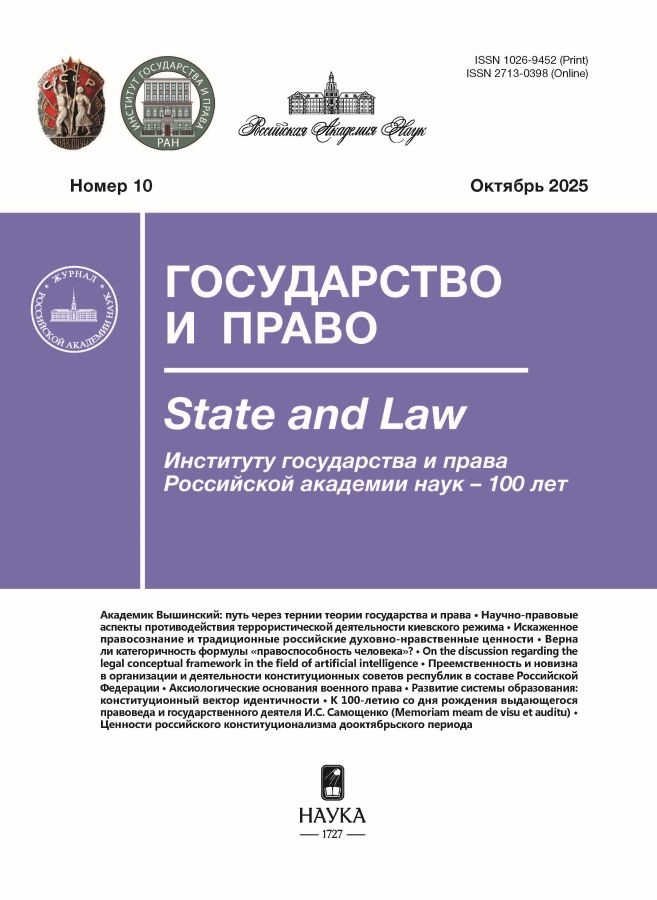Формирование верхних палат парламентов в федеративных государствах: сравнительное исследование
- Авторы: Фарукшин М.Х.1
-
Учреждения:
- Казанский (Приволжский) федеральный университет
- Выпуск: № 8 (2024)
- Страницы: 84-93
- Раздел: Сравнительное правоведение
- URL: https://kld-journal.fedlab.ru/1026-9452/article/view/649096
- DOI: https://doi.org/10.31857/S1026945224080088
- ID: 649096
Цитировать
Полный текст
Аннотация
В статье представлены результаты сравнительного анализа формирования верхних палат парламентов в двадцати федеративных государствах. Отмечается зависимость представительства субъектов федерации в верхней палате от способа формирования последней. Выделяются четыре основных способа. Показано влияние способа формирования верхней палаты на степень связи сенаторов с субъектами федерации. Обосновывается положение о том, что наиболее прочной эта связь бывает в случаях, когда своих представителей в верхнюю палату делегируют сами субъекты федерации. Утверждается об отсутствии линейной связи между способом формирования верхней палаты и объемом ее полномочий. Последний зависит от институционализации, в основе которой – политические интересы правящих групп.
Ключевые слова
Полный текст
Об авторах
Мидхат Хабибович Фарукшин
Казанский (Приволжский) федеральный университет
Автор, ответственный за переписку.
Email: Midkhat.Farukshin@kpfu.ru
доктор философских наук, профессор, профессор-консультант
Россия, г. КазаньСписок литературы
- Авакьян С. А. Совет Федерации: четверть века проблем формирования палаты // Вестник Московского ун-та. Сер. 11. 2020. № 1. С. 12.
- Виноградова Е. В., Данилевская И. Л. Совет Федерации – от депутатов до сенаторов. К вопросу формирования верхней палаты парламента в конституционной модели современной России // Государство и право. 2020. № 9. С. 11.
- Галузо В. Н., Канафин Н. А. О парламентаризме в Башкортостане // Право и государство: теория и практика. 2019. № 4. С. 39–44.
- Федосов П. А. Двухпалатные парламенты: европейский и отечественный опыт (II) // Полис. Политические исследования. 2001. № 2. С. 176.
- Филиппова Н. А. Представительство субнациональных интересов в Совете Федерации Федерального Собрания РФ: функциональная и делегативная модель // Политэкс. 2007. Т. 3. № 2. С. 68.
- Червинская А. П. Бикамерализм как принцип устройства парламента: исторический опыт и проблемы современной России // Государство и право. 2019. № 10. С. 170.
- Bicameralism and Policy Responsiveness to Public Opinion // American Journal of Political Science. January 2023. Р. 15.
- Bulmer E. Bicameralism. Stockholm, 2017. Pp. 4, 19.
- Ezrow L., Fenzl M., Hellwig T. Bicameralism and Policy Responsiveness to Public Opinion // American Journal of Political Science. February 2023. P. 4.
- Noël T. Second chambers in federal systems. Stockholm, 2022. Pp. 8, 10, 11.
- Rogers J. R. The Impact of Bicameralism on Legislative Production // Legislative Studies Quarterly. 2003. Vol. XXVIII. No. 4. P. 510.
- Weieler P. Confederation Discontents and Constitutional Reform: The Case of the Second Chamber // The University of Toronto Law Journal. 1979. Vol. 29. No. 3. P. 262
- Wieciech T. and Koschalka B. Formulas of Representation of Constituent Units in the Parliaments of Federal States // Politeja. 2008. No. 10/1. Pp. 392, 399, 408, 409.
Дополнительные файлы











